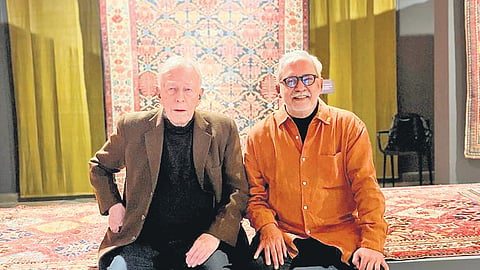

One often admires the intricate designs and details on rugs, their vibrant colour combinations catching the eye. The geometric patterns, aligning with those of flora and fauna, draw attention to their rich craftsmanship. ‘Nomads’, an ongoing exhibition at the National Crafts Museum till February 12, brings together private collections of such textiles from Mandeep and David Housego who own the Shades of India brand. Several pieces in the exhibition are from collections of carpet connoisseurs Danny and Renuka Mehra.
Hung across the old audio-visual gallery and the chariot courtyard, the extensive collection features stunning rugs, horse blankets, saddle and gelims (flatweave rugs) woven by nomads from Anatolia to Tibet in the 19th and early 20th century.
Housego says he began collecting the pieces when he lived for about six years in Iran in the 1970s. “It was a time when you could travel everywhere in the country as well as in neighbouring Afghanistan. I was struck by the beauty of the tribal pieces—rugs, horse blankets, saddle bags. They had a very contemporary sense of design, colour and form. I spent a lot of time in the bazaars, in carpet shops and even travelling with the tribes. I have continued collecting since, most recently in Uzbekistan.”
Danny Mehra points out that the countries from where he has sourced the rug pieces are Armenia, Azerbaijan, Georgia and Dagestan. Also the Caucasus—parts of Iran, Syria and Turkey and the five ‘stans’—Uzbekistan, Kyrgyzstan, Tajikistan, Kazakhstan and Turkmenistan. The rugs are mostly of 19th century vintage.
Each carpet has a story to tell and is inspired by its immediate surroundings, Mehra says. “We will never know what the nomadic lady who wove it had in mind when she was weaving it. But these designs apparently had meanings; even the colours had meanings. They were using their own lives as a metaphor so, these carpets have flora- and fauna-inspired motifs,” he adds.
Made from hand-spun and woven wool, they were dyed in natural colours back then. Despite the passage of several decades, the patterns and vibrant hues remain undiminished; each work traces different styles of the nomadic tribes, reflecting their culture and movement. The tribes would often move with their animal flocks during changing seasons to different locations, and depict the displacement through their art. A rare knotted interpretation of a 19th century verneh (flatweave cover), for instance, depicts a caravan of nomadic people, domestic possessions and animals on a seasonal migration journey, in search of greener pastures.
“The exhibition contains some exceptional pieces both from Danny’s collection and mine,” says Housego. “I love, for instance, the Bidjar gelim with a red background and a three-diamond rug motif in a Herati design. The combination of flat weave and pile rug is almost unique.”
There are several rugs as well with widely different interpretations of the boteh (paisley) motif so well known in India; it goes to show how designs and aesthetics travelled and were shared by people of distant regions and then used in different ways.
“Because they were always moving, their designs were changing too. When we see Kashmiri designs on textiles, they tend to have a fixed pattern. These designs, on the other hand, have changed with influences from recurring motifs,” Mehra adds.
Mehra believes that calling the pieces carpets would be wrong, he instead calls them works of art. “‘Carpet’ is only five per cent of the definition. They are works of art. They were used by the nomads for everything - on their floors, walls, curtains, mattresses, blankets, bags, horse blankets among other things. So, to me they are heirlooms, and they must be acquired the way paintings in an art gallery are,” he says.